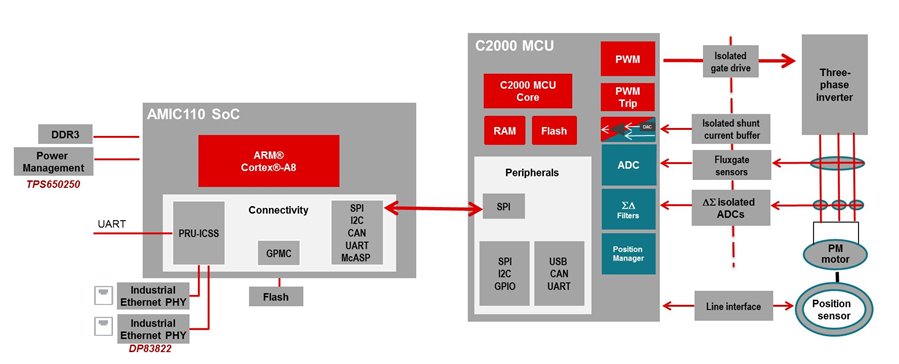SSZTA46 June 2017 AMIC110 , DP83822I
Industrial Ethernet protocols are an important part of factory automation. Today, there are many protocol standards including EtherCAT, Profinet, Powerlink, Ethernet/Industrial Protocol (IP) and Sercos III. Having so many different protocols makes it challenging to develop solutions that can work for several different networks. One solution is to have a single device that’s reprogrammable for different protocols, like TI’s newly announced AMIC110 system on chip (SoC).
TI Sitara™ ARM® processors can enable more than 10 industrial communication standards through the programmable real-time unit industrial communications subsystem (PRU-ICSS). Adding a full-featured ARM® processor may be impractical if there is already an existing applications processor on the design. If that’s the case, you can leverage your existing work but also enable PRU-ICSS functionality by adding a communications processor like the AMIC110 SoC. Although the AMIC110SoC contains an ARM Cortex®-A8 core, it serves to run Ethernet stacks instead of acting as the primary processor.
As a communication processor, the AMIC110 SoC provides a flexible alternative over static solutions. One advantage is that the AMIC110 SoC’s software programmability makes it possible for you to run different communication standards instead of being tied to just one. That makes it possible to reuse the same device in different projects that use different protocols. The re-programmability also makes it easier to upgrade if a protocol releases a feature change, or completely reprogram the SoC in case a new protocol is released. These qualities make the AMIC110 SoC an excellent way to add industrial communication to a device.
For example, a motor-control application may use a C2000™ microcontroller (MCU) to control a motor, as shown in Figure 1. To add a protocol like EtherCAT, the C2000 MCU can communicate to the AMIC110 through Serial Peripheral Interface (SPI), and the AMIC110 SoC will handle the protocol-based communication to the rest of the network.
 Figure 1 Example Implementation of
Motor Control with AMIC110 and C2000
Figure 1 Example Implementation of
Motor Control with AMIC110 and C2000AMIC110 SoCs are part of the Sitara processor family and share many of its benefits, like using the processor software development kit (SDK) as a standard software platform. The processor SDK makes it easy to migrate software between Sitara processors, which reduces learning time on new processors and enables you to leverage existing work well into the future.
Additional Resources
- Learn more about the DP83822I industrial Ethernet PHY.
- Start developing with the AMIC Industrial Communications Engine (ICE).
- Add industrial communications to your C2000 project with the EtherCAT Slave and Multi-Protocol Industrial Ethernet Reference Design.